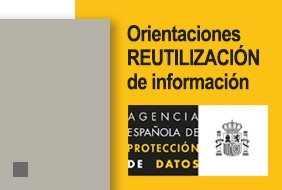Guidance on data protection in the re-use of public sector information
Fecha del documento: 13-10-2016

Law 18/2015, of 9 July, amending Law 37/2007, of 16 November, on re-use of public sector information, provides that the authorities and public bodies have a clear obligation to authorize the re-use of their information, including those institutions in the cultural field such as museums, archives and libraries.
In order that the provision of information for its re-use does not interfere with the privacy of personal data, the Spanish Data Protection Agency has published a Guidance document on data protection in the re-use of public sector information which gathers all aspects to be considered by the public sector to release data ensuring the fundamental right to data protection recognized in Article 18.4 of the Constitution, in the Article 4.6 of Law 15/1999 on Protection of Personal Data and in the Article 8 of the Charter of Fundamental Rights of the European Union.
As laid out in the document, the treatment and re-use of public sector information by the re-user may involve the combination of that information with other data sources, using technologies of big data or data mining that limit the monitoring and control over the use of public open data and, therefore, could cause uncertainty about the privacy of such information. Nevertheless, according to the AEPD, these associated risks should not lead to a restriction of re-use considering its advantages to the whole society. The guide attempts to answer this question, highlighting the importance of preventive methodologies such as the assessment of re-use impact in the protection of personal data -which analyzes the potential risks that the treatment of the personal data may involve- and proactive solutions such as the anonymization of data, as well as the legal guarantees and tools needed thereof.
The document shows how to evaluate the impact on data protection by the body that authorizes the re-use of the information, which can develop the analysis independently or with the help of the re-user, without providing, in such case, sensitive or personal data.
In addition, the text indicates how anonymization can be strengthened through legally binding commitments such as the express indication to prohibit the re-identification and use of personal data in decision-making. Finally, it also includes some example measurements to ensure the compliance with these legal guarantees: from periodic assessments of the re-identification risks; audits on the use of reused information or the inclusion of warnings on the re-identification of personal data on websites.
Thanks to this guidance, the Spanish Data Protection Agency opens the way to spread good practices in finding the answer to one of the main risks associated with the re-use of public sector information such as the re-identification of citizens, instructing managers of public institutions in how to facilitate open data in compliance with the legal guarantees of data protection.











